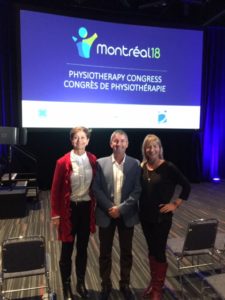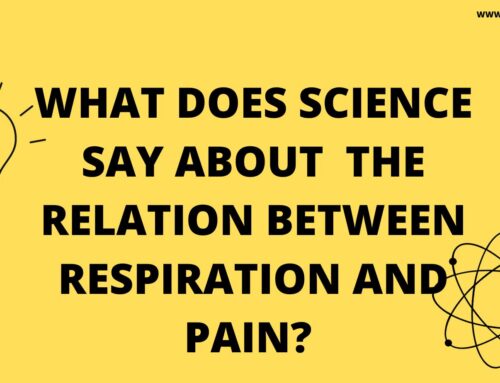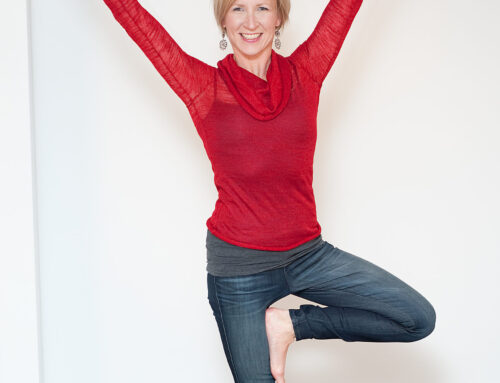 History was made in November 2018 in Montreal, Canada at Canadian Physiotherapy Association (CPA) Congress where we (Neil Pearson, Diana Perez, Shelly Prosko – physiotherapists/yoga therapists) presented Yoga Therapy: An Integrative Biopsychosocial Approach to Enhance Physiotherapy Practice to a conference room filled with physiotherapists from across the country who were interested in learning more about yoga and its integration into physiotherapy practice. We also presented a full day pre-congress course on this integration with a focus on chronic pain, musculoskeletal and pelvic floor rehabilitation and wellness care.
History was made in November 2018 in Montreal, Canada at Canadian Physiotherapy Association (CPA) Congress where we (Neil Pearson, Diana Perez, Shelly Prosko – physiotherapists/yoga therapists) presented Yoga Therapy: An Integrative Biopsychosocial Approach to Enhance Physiotherapy Practice to a conference room filled with physiotherapists from across the country who were interested in learning more about yoga and its integration into physiotherapy practice. We also presented a full day pre-congress course on this integration with a focus on chronic pain, musculoskeletal and pelvic floor rehabilitation and wellness care.
Our intentions included to enhance our colleagues’ understanding of the similarities and differences between yoga, yoga therapy and yoga in physiotherapy (PT) and to appreciate the value and effectiveness of integrating yoga therapy into PT.
We spent time discussing the history of yoga and yoga therapy and the current trends and examples of yoga in PT. We explored various classical interpretations and paths of yoga and we shared The International Association of Yoga Therapists (IAYT) definition of yoga therapy and outlined the organization’s work and ongoing dedication towards the progression of the field of yoga therapy.
We wanted to ensure we conveyed the message that integrating yoga therapy into PT is not just about asana or pranayama prescription. We made an effort to be clear in our explanations that yoga provides an accessible biopsychosocial-spiritual framework from which we work and that it includes both practices and philosophy. We summarized the science surrounding the therapeutic effects of yoga with an emphasis on the conditions and special populations that we as physiotherapists (PTs) commonly work with.
 Overall it was a tremendous success. We were pleasantly surprised at the exceptional turnout, positive feedback and engaging discussions that took place during the Q & A that went over time because of the abundant curiosity and interest.
Overall it was a tremendous success. We were pleasantly surprised at the exceptional turnout, positive feedback and engaging discussions that took place during the Q & A that went over time because of the abundant curiosity and interest.
Some of the questions asked by the audience that we addressed were:
How do I stay within scope of practice? Is it ok to use some yoga techniques in PT practice without being a yoga therapist? How do you integrate yoga philosophy into clinical practice? How has integrating yoga therapy into your PT practice changed the way you practice and what are the benefits? How do I learn more and where do I start?
Perhaps our PT profession is finally ready and hungry for this integration! We are instructed to use a biopsychosocial approach, but are left with challenges on how to effectively deliver this approach within our scope of practice. Yoga therapy can provide us with such a framework. Physiotherapists are well positioned to integrate yoga therapy into rehabilitation and healthcare. The growing popularity of yoga being used by PTs is testimony to the potential value this integration holds for both the PT and the patient.
Many of us have been dedicated to bridging this gap between yoga therapy and PT for decades. On behalf of our colleagues who are also dedicated to this path, we want to thank CPA Congress for giving us the honour to share this work and these messages at this prestigious national physiotherapy conference that is committed to providing value, excellence and evidence informed education for CPA members. Thank you to IAYT for paving a pathway and providing a platform to make this integration more accessible, feasible and evidence-informed.
To our bridgebuilding Physiotherapy/Yoga therapy hybrid colleagues: we are another step closer to having this integration acknowledged, supported and respected as a viable and effective therapeutic approach for our profession!
In service,
Shelly Prosko, PT, PYT, C-IAYT





and the “nice” Canadians shall lead us!…. thank you to all 3 of you pioneers for your contributions!
…and thank you, Matt, for being one of our original pioneers on this path and for all your dedication and continued work you are doing to bridge these fields. Thank you for being a role model, resource and for providing support for many of us!
Congratulations Shelley. This is great! I’m not a physiotherapist but I am a C-IAYT . I think that it’s great to share this info with physiotherapists not only to inform themselves and their practice but also for their patients and for us Yoga Therapists who may receive referrals because of it.
Joanne,
Thanks for reading and for taking the time to comment. I agree with you and part of my speaking/teaching includes advocating for and educating about yoga therapy to HCPs who otherwise do not know it exists. I talk about the varying reasons why HCPs may want to learn more about who/what is out there in their community offering yoga therapy, the science behind some of what we know about effects of yoga, and the growing number of people seeking out yoga for their healthcare needs. As you are likely aware, a growing number of HCPs are recommending yoga to their patients — ultimately enhancing patient care and outcomes and meeting the increasing demands from the population who want to use yoga for their health concerns — so it’s part of my mission and responsibility to share these messages as accurately as I can.
Thanks again for reading, for commenting, and for all the good work you are doing as a yoga therapist in helping those who suffer.
Shelly